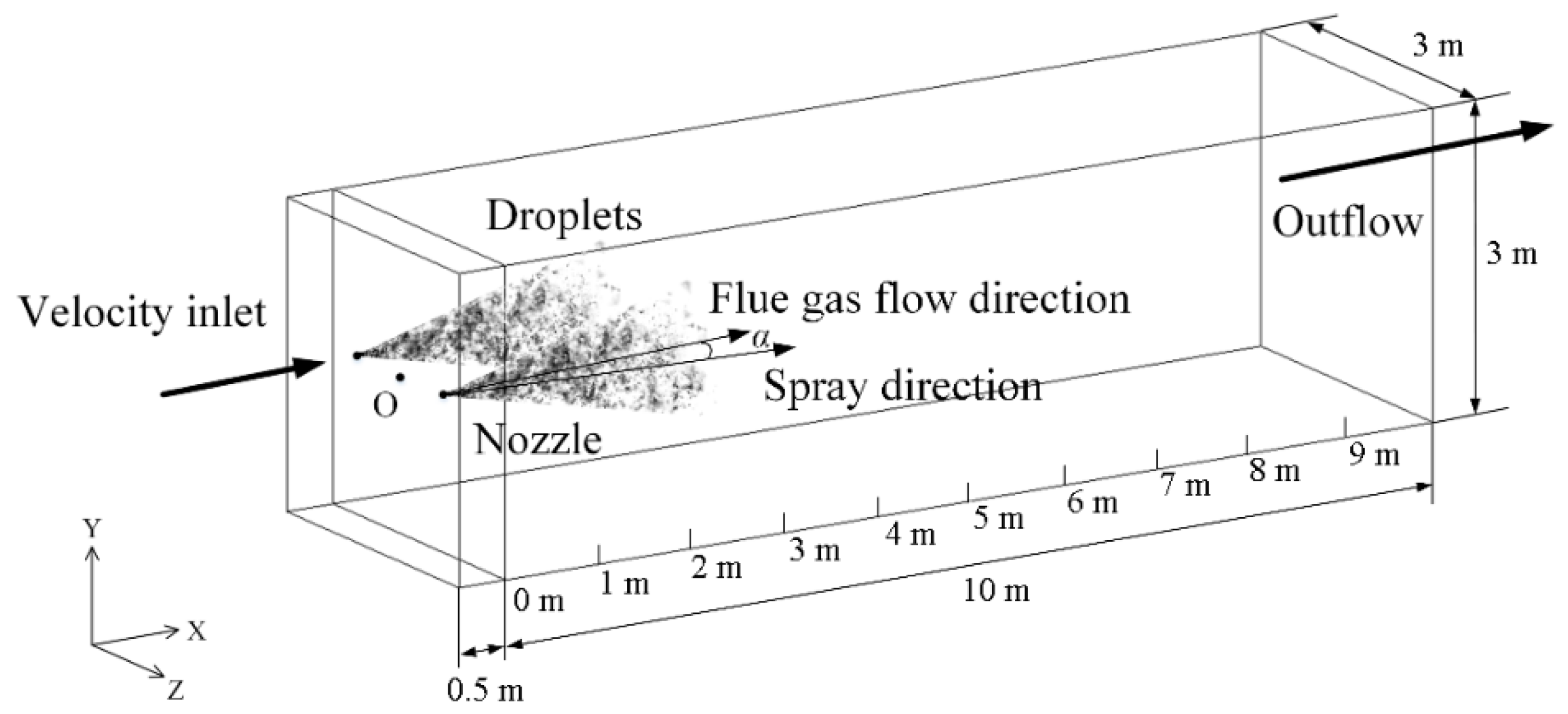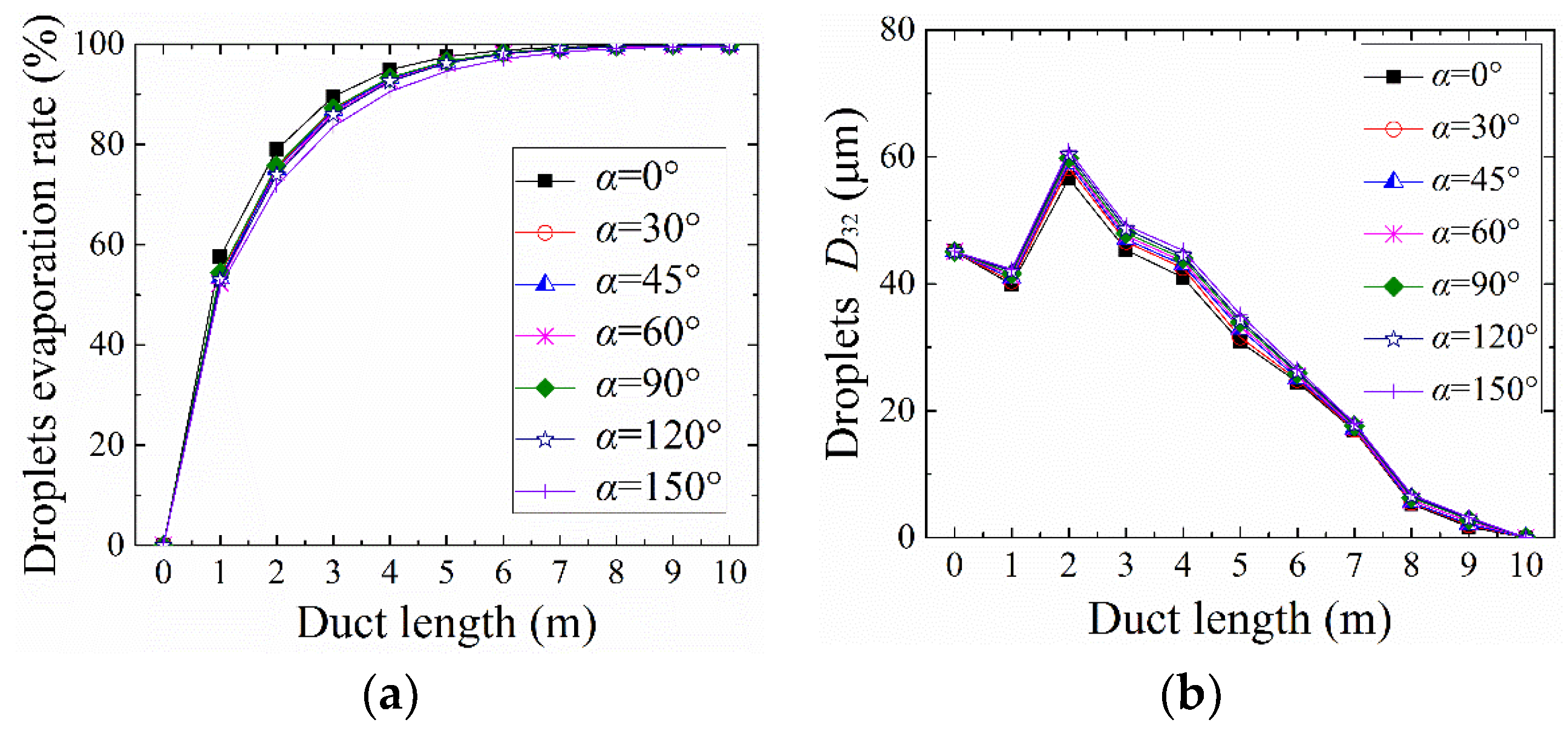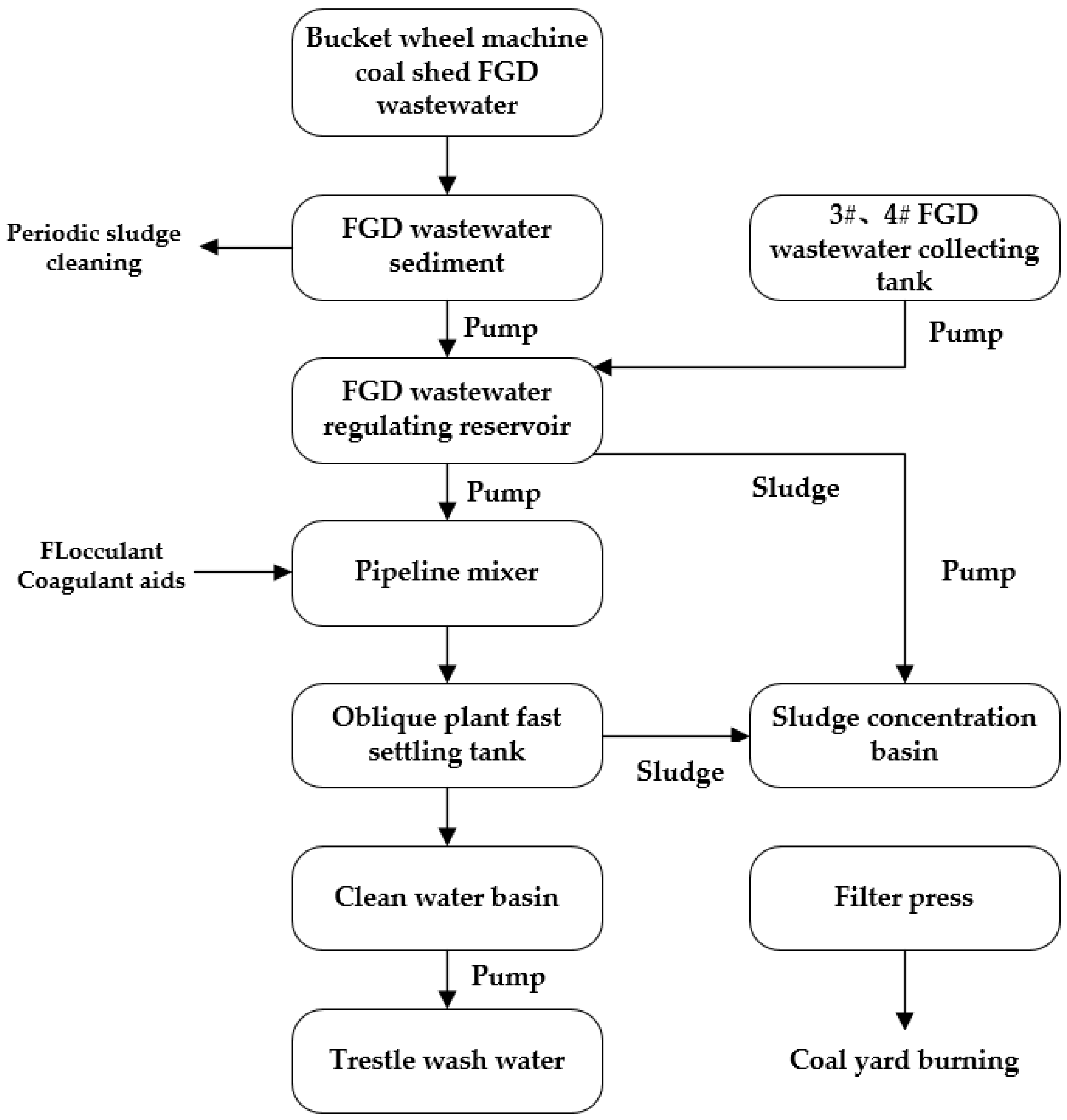Numerical Simulation of Multi-Nozzle Droplet Evaporation Characteristics for Desulfurization Wastewater
Abstract
:1. Introduction
2. Mathematical Model and Numerical Approach
2.1. Physical Model
2.2. Governing Equations
2.2.1. Continuous Phase (Flue Gas)
2.2.2. Discrete Phase (Water Droplets)
- (1)
- The droplets are uniformly spherical during the entire evaporation process;
- (2)
- The latent heat of vaporization, specific heat capacity, surface tension and other parameters of the droplet change with the temperature of the droplet;
- (3)
- We ignore the effect of radiative heat transfer on droplet evaporation;
- (4)
- We ignore the influence of droplet internal circulation and internal thermal resistance on droplet evaporation.
2.3. Boundary Condition
2.4. Meshing and Mesh Independence Test
2.5. Numerical Calculation
2.6. Experimental Verification
3. Least Square Support Vector Machine (LSSVM) Prediction Model
4. Results and Analysis
4.1. Physical Parameters and Evaluation Indexes of Flue Gas and Liquid Droplets
4.2. Overview of Wastewater Droplet Evaporation in Flue Duct
4.3. Effect of Influence Factors
4.3.1. Initial Temperature of Atomized Droplet Groups
4.3.2. Temperature of Flue Gas
4.3.3. Spraying Flow Rate of Nozzle
4.3.4. Spray Full Cone Angle
4.3.5. Spray Direction of Nozzles
4.4. Multi-Input Multi-Output (MIMO) Droplet Evaporation LSSVM Prediction Model
4.5. Optimization of Engineering Example
5. Conclusions
- (1)
- A shorter installation distance between two adjacent nozzles leads to a lower evaporation rate of droplets. Droplets with higher initial temperatures require a shorter time and distance for complete evaporation. On the other hand, a higher flue gas temperature makes atomized droplets evaporate faster. Properly increasing the flue gas velocity can improve the evaporation quality of the atomized droplets.
- (2)
- A multi-nozzle arrangement with a small flow rate can improve the evaporation quality of the atomized droplets; when the spray direction of the nozzle is parallel to the flow direction of the flue gas, the evaporation mass flow rate of the atomized droplet group can be maximized.
- (3)
- A LSSVM droplet evaporation prediction model is established, which can be used for the time series prediction of the droplet evaporation rate with high prediction accuracy.
- (4)
- An optimization plan for evaporation treatment technology for FGD wastewater sprayed into a flue is proposed. Through numerical simulations, it is verified that the abovementioned optimized treatment process and nozzle layout scheme can meet the actual engineering requirements.
- (5)
- This research can not only provide a theoretical foundation for the process design and performance control of FGD wastewater flue gas evaporation in power plants but can also aid with nozzle selection and management of FGD wastewater spray evaporation systems under actual operating conditions in power plants.
Author Contributions
Funding
Conflicts of Interest
References
- Koralegedara, N.H.; Pinto, P.X.; Dionysiou, D.D.; Al-Abed, S.R. Recent advances in flue gas desulfurization gypsum processes and applications—A review. J. Environ. Manag. 2019, 251, 109572. [Google Scholar] [CrossRef]
- Yao, X.; Zhang, M.; Deng, B.; Yang, X.; Yang, H. Primary Research of a New Zero-Liquid-Discharge Technology of Wet Flue Gas Desulfurization Wastewater by Low-Rank Heat from Flue Gas. Energies 2021, 14, 4259. [Google Scholar] [CrossRef]
- Muhammad, Y.; Lee, W. Zero-liquid discharge (ZLD) technology for resource recovery from wastewater: A review. Sci. Total Environ. 2019, 681, 551–563. [Google Scholar] [CrossRef] [PubMed]
- Feng, S.; Xiao, L.; Ge, Z.; Yang, L.; Du, X.; Wu, H. Parameter analysis of atomized droplets sprayed evaporation in flue gas flow. Int. J. Heat Mass Transf. 2019, 129, 936–952. [Google Scholar] [CrossRef]
- Ashgriz, N. Handbook of Atomization and Sprays; Springer: New York, NY, USA, 2011. [Google Scholar]
- Deng, J.-J.; Pan, L.-M.; Chen, D.-Q.; Dong, Y.-Q.; Wang, C.-M.; Liu, H.; Kang, M.-Q. Numerical simulation and field test study of desulfurization wastewater evaporation treatment through flue gas. Water Sci. Technol. 2014, 70, 1285–1291. [Google Scholar] [CrossRef]
- Hou, Y.; Tao, Y.; Huai, X.; Guo, Z. Numerical characterization of multi-nozzle spray cooling. Appl. Therm. Eng. 2012, 39, 163–170. [Google Scholar] [CrossRef]
- Lupo, G.; Gruber, A.; Brandt, L.; Duwig, C. Direct numerical simulation of spray droplet evaporation in hot turbulent channel flow. Int. J. Heat Mass Transf. 2020, 160, 120184. [Google Scholar] [CrossRef]
- Markadeh, R.S.; Arabkhalaj, A.; Ghassemi, H.; Azimi, A. Droplet evaporation under spray-like conditions. Int. J. Heat Mass Transf. 2020, 148, 119049. [Google Scholar] [CrossRef]
- Tissot, J.; Boulet, P.; Trinquet, F.; Fournaison, L.; Macchi-Tejeda, H. Air cooling by evaporating droplets in the upward flow of a condenser. Int. J. Therm. Sci. 2011, 50, 2122–2131. [Google Scholar] [CrossRef]
- Kim, H.; Sung, N. The effect of ambient pressure on the evaporation of a single droplet and a spray. Combust. Flame 2003, 135, 261–270. [Google Scholar] [CrossRef]
- Gradinger, T.; Boulouchos, K. A zero-dimensional model for spray droplet vaporization at high pressures and temperatures. Int. J. Heat Mass Transf. 1998, 41, 2947–2959. [Google Scholar] [CrossRef]
- Godsave, G. Studies of the combustion of drops in a fuel spray—The burning of single drops of fuel. Symp. Combust. 1953, 4, 818–830. [Google Scholar] [CrossRef]
- Sazhin, S.; Shishkova, I.; Kryukov, A.; Levashov, V.; Heikal, M. Evaporation of droplets into a background gas: Kinetic modelling. Int. J. Heat Mass Transf. 2007, 50, 2675–2691. [Google Scholar] [CrossRef]
- Ranz, W.E.; Marshall, W.R. Evaporation from drops—Part 1. Chem. Eng. Prog. 1952, 48, 141–148. [Google Scholar]
- Ranz, W.E.; Marshall, W.R. Evaporation from drops—Part 2. Chem. Eng. Prog. 1952, 48, 173–180. [Google Scholar]
- Tseng, C.; Viskanta, R. Enhancement of water droplet evaporation by radiation absorption. Fire Saf. J. 2006, 41, 236–247. [Google Scholar] [CrossRef]
- Sureshkumar, R.; Kale, S.R.; Dhar, P.L. Heat and mass transfer processes between a water spray and ambient air—I. Experimental data. Appl. Therm. Eng. 2008, 28, 349–360. [Google Scholar] [CrossRef]
- Sureshkumar, R.; Kale, S.R.; Dhar, P.L. Heat and mass transfer processes between a water spray and ambient air—II. Simulations. Appl. Therm. Eng. 2008, 28, 361–371. [Google Scholar] [CrossRef]
- Okada, S.; Ohsaki, S.; Nakamura, H.; Watano, S. Estimation of evaporation rate of water droplet group in spray drying process. Chem. Eng. Sci. 2020, 227, 115938. [Google Scholar] [CrossRef]
- Gonzalez-Juez, E.D.; Kerstein, A.R. Multiscale modeling of turbulent atomization: Droplet-size sampling. Int. J. Multiph. Flow 2020, 128, 103268. [Google Scholar] [CrossRef]
- Yu, H.; Jin, Y.C.; Cheng, W.; Yang, X.; Peng, X.; Xie, Y. Multiscale simulation of atomization process and droplet particles diffusion of pressure-swirl nozzle. Powder Technol. 2021, 379, 127–143. [Google Scholar] [CrossRef]
- Shlegel, N.; Strizhak, P.; Tarlet, D.; Bellettre, J. Comparing the integral characteristics of secondary droplet atomization under different situations. Int. Commun. Heat Mass Transf. 2019, 108, 104329. [Google Scholar] [CrossRef]
- Fu, H.; Zhao, R.; Long, W.; Cheng, W. Study on cooling performance of rapid cooling system based on vacuum spray flash evaporation. Appl. Therm. Eng. 2021, 201, 117751. [Google Scholar] [CrossRef]
- Sarmadian, A.; Dunne, J.; Jose, J.T.; Long, C.; Pirault, J.-P. Temperature control of vibrating heat-generating hardware using spray evaporative cooling in the nucleate boiling region. Appl. Therm. Eng. 2021, 200, 117710. [Google Scholar] [CrossRef]
- Sazhin, S.S. Advanced models of fuel droplet heating and evaporation. Prog. Energy Combust. Sci. 2006, 32, 162–214. [Google Scholar] [CrossRef]
- Brown, B. Evaporation and droplet growth in gaseous media. Cryogenics 1960, 1, 55. [Google Scholar] [CrossRef]
- Jen, T.-C.; Li, L.; Cui, W.; Chen, Q.; Zhang, X. Numerical investigations on cold gas dynamic spray process with nano- and microsize particles. Int. J. Heat Mass Transf. 2005, 48, 4384–4396. [Google Scholar] [CrossRef]
- Chen, W.; Chong, D.; Yan, J.-J.; Dong, S.-C.; Liu, J.-P. Numerical Investigation of Two-Phase Flow in Natural Gas Ejector. Heat Transf. Eng. 2014, 35, 738–745. [Google Scholar] [CrossRef]
- Liu, A.B.; Mather, D.; Reitz, R.D. Modeling the Effects of Drop Drag and Breakup on Fuel Sprays. Tech. Paper 1993, 298, 83–95. [Google Scholar]
- O’Rourke, P.; Amsden, A. The TAB Method for Numerical Calculation fof Spray Droplet Breakup. Sae Paper 1987, 12. [Google Scholar] [CrossRef] [Green Version]
- Rosin, P.; Rammler, E. The Laws Governing the Fineness of Powdered Coal. J. Inst. Fuel 1933, 7, 29–36. [Google Scholar]




















| Physical Parameter Unit | Temperature (T, K) | Density (ρ, kg/m3) | Specific Heat (cp,kJ/(kg·K)) | Thermal Conductivity (λ, W/(m·K)) |
|---|---|---|---|---|
| Flue gas | 403.15 | 0.8894 | 1.0767 | 3.394 × 10−2 |
| Physical Parameter Unit | Temperature (T, K) | Density (ρ, kg/m3) | Specific Heat ((cp,kJ/(kg·K))) | Thermal Conductivity (λ, W/(m·K)) |
|---|---|---|---|---|
| Wastewater | 323.15 | 1074 | 4.174 | 64.8 |
| Size Range of Diameter dd (μm) | Proportion of Mass Fraction | |||
|---|---|---|---|---|
| First | Second | Third | Fourth | |
| 0–20 | 0.52 | 0.12 | 0.05 | 0.03 |
| 20–40 | 0.35 | 0.40 | 0.15 | 0.04 |
| 40–60 | 0.06 | 0.35 | 0.35 | 0.12 |
| 60–80 | 0.04 | 0.08 | 0.35 | 0.36 |
| 80–100 | 0.03 | 0.05 | 0.10 | 0.45 |
Publisher’s Note: MDPI stays neutral with regard to jurisdictional claims in published maps and institutional affiliations. |
© 2022 by the authors. Licensee MDPI, Basel, Switzerland. This article is an open access article distributed under the terms and conditions of the Creative Commons Attribution (CC BY) license (https://creativecommons.org/licenses/by/4.0/).
Share and Cite
Guo, X.; Wu, J.; Du, X.; Zhang, Y.; Feng, S.; Liu, S. Numerical Simulation of Multi-Nozzle Droplet Evaporation Characteristics for Desulfurization Wastewater. Energies 2022, 15, 5180. https://doi.org/10.3390/en15145180
Guo X, Wu J, Du X, Zhang Y, Feng S, Liu S. Numerical Simulation of Multi-Nozzle Droplet Evaporation Characteristics for Desulfurization Wastewater. Energies. 2022; 15(14):5180. https://doi.org/10.3390/en15145180
Chicago/Turabian StyleGuo, Xinrui, Jiangbo Wu, Xiaoze Du, Yaocong Zhang, Shuqin Feng, and Shujun Liu. 2022. "Numerical Simulation of Multi-Nozzle Droplet Evaporation Characteristics for Desulfurization Wastewater" Energies 15, no. 14: 5180. https://doi.org/10.3390/en15145180






